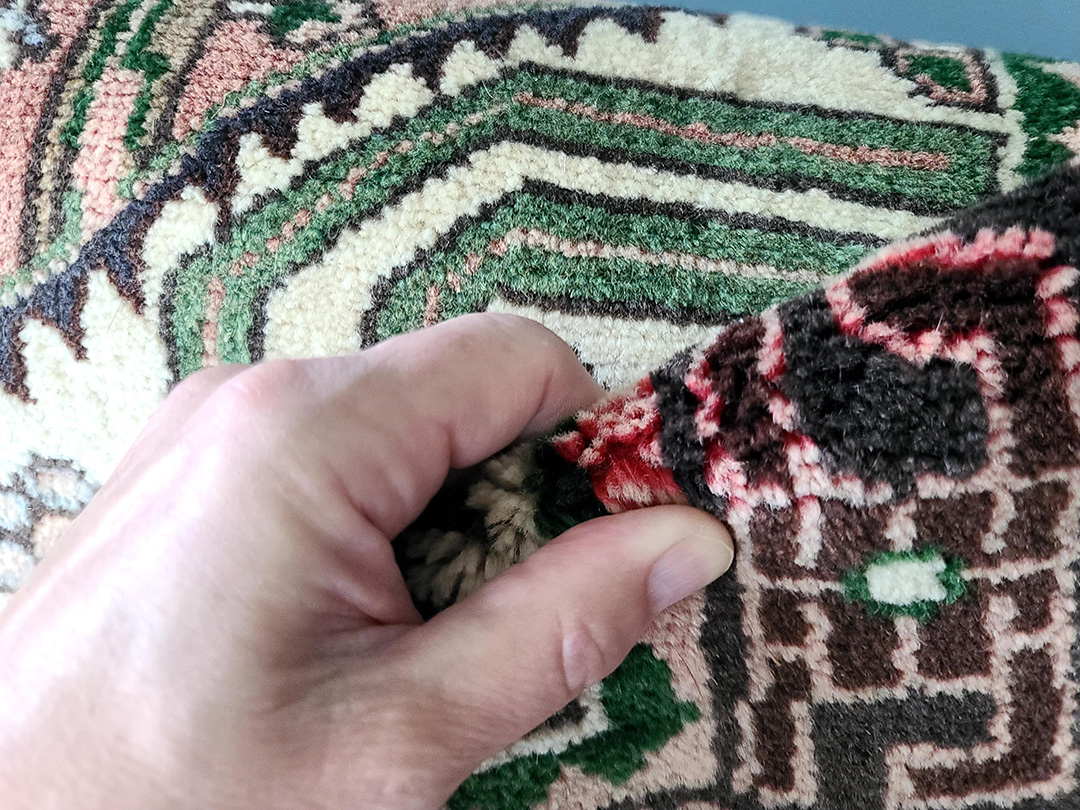
Chemically Washed Rugs
Chemically washed rugs are very common. Consumers seem to like them. Why? There seems to be many different advantages like; they feel softer, more silky. The colors are not so garish, not so harsh and loud, better suiting the western palette. They look like antique rugs, older, maybe more valuable, or desirable. Chemically washed rugs have a nice “sheen”. They look better, more silky. Some believe that they have a nice “patina” or they like that “distressed” look.
Chemically washed rugs come with many different names; luster washed, antique wash, distressed, and many creative terms to convince customers that they are getting something new and different. But it is chemically washing something good for the rug? No, absolutely not. Unless selling a rug that might not otherwise sell is your only goal.
What does chemically washing do to wool? It very often removes the cuticle of the wool fibers. The cuticle is the protective, outer layer of the wool fiber. Removing the cuticle weakens the strength and durability of the wool. The wool is more sensitive to sunlight and ultraviolet light damage, and is more chemical sensitive too. The wool becomes less stain and soil resistant because of losing much of its natural repellency. When high pH is used for chemically washing, it disrupts the isoionic balance of the wool, again weakening the fiber. These rugs become very sensitive to acids and alkaline spotters and
cleaning solutions, often color shifting with the pH change. When redox reactions are used to chemically wash wool rugs (the most common system) it also breaks the disulfide bonds of the wool’s protein molecules, thus weakening the wool fibers.
Therefore chemically washed wool rugs require extra care and special cleaning considerations.
Cautions:
1. Always inspect and pre-test. Document and photograph. Note all pre-existing damage.
2. Chemically washing is pre-existing damage. Grin the pile open and look at the color of the
base of the pile yarns compared to the tips. Also compare the color of the face and
the back of the rug.
3. Look for sun fading quote for color repairs and quote for U.V. Protection with Fluorosolve.
4. Test for pH. Quote for correcting pH.
5. Test for redox balance. Quote for correcting.
6. Test for crocking and bleeding.
7. Look for physical damage. Quote for repairs.
8. Check wool for damage. Is it dried out? Is it brittle and are the fibers breaking? Are the
colors dull? Is the hand harsh? Quote for revitalizing the damaged will with Wool Rug
Revitalizer.
9. Have release of liability signed before cleaning.
Cleaning procedures:
1. Dust rug.
2. If no color issues, wet out with cool, clean water.
3. Apply diluted Chem Max Oriental Rug Shampoo to entire rug including fringes, front and
back. This shampoo has a neutral pH to keep the face fibers from shifting colors from
pH changes.
4. Work in with shampooer, hand brush or other method, front and back, including fringes.
5. Allow a dwell time of 20 to 30 minutes for the Oriental Rug Shampoo to break down and
digest soils and stains.
6. Flush rinse with cool, clear water front and back, until water runs clear.
7. (A) Squeegee, role, wring out, extract or centrifuge to remove excess water.
(B) If using a flatbed washer or other system, run through as normal.
8. Strongly recommend fiber protection with Fluorosolve with U.V. Blocker to prevent any
more ultraviolet light damage.
9. Consider adjusting the pH of the wool to the correct 5.5 pH, or as close as possible.
10. Consider. Balancing the redox potential back to 500 millivolts, or as close as reasonable.
Charge accordingly.
11. Strongly recommend repairing the wool fibers with Wool Rug Revitalizer. Charge
accordingly.
12. Speed dry.
13. Groom rug with pile lay and comb out fringes.
Note: if colors are migrating add a rinse cycle of Dye Release solution to to rinse away
color contamination.
